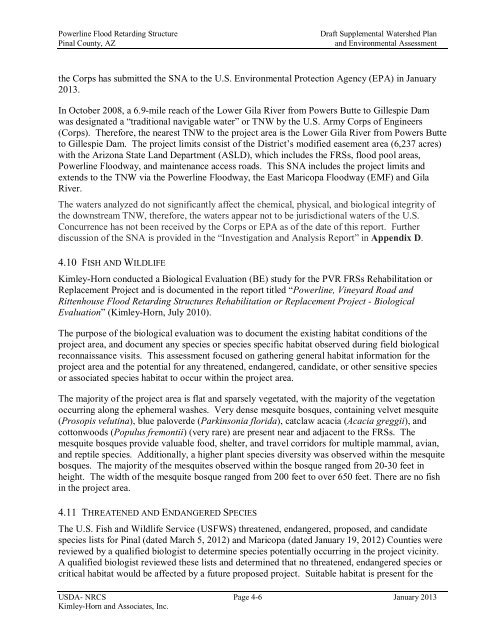Powerline Plan and Environ. Assessment Jan. 2013 - Flood Control ...
Powerline Plan and Environ. Assessment Jan. 2013 - Flood Control ...
Powerline Plan and Environ. Assessment Jan. 2013 - Flood Control ...
Create successful ePaper yourself
Turn your PDF publications into a flip-book with our unique Google optimized e-Paper software.
<strong>Powerline</strong> <strong>Flood</strong> Retarding Structure<br />
Pinal County, AZ<br />
Draft Supplemental Watershed <strong>Plan</strong><br />
<strong>and</strong> <strong>Environ</strong>mental <strong>Assessment</strong><br />
the Corps has submitted the SNA to the U.S. <strong>Environ</strong>mental Protection Agency (EPA) in <strong>Jan</strong>uary<br />
<strong>2013</strong>.<br />
In October 2008, a 6.9-mile reach of the Lower Gila River from Powers Butte to Gillespie Dam<br />
was designated a “traditional navigable water” or TNW by the U.S. Army Corps of Engineers<br />
(Corps). Therefore, the nearest TNW to the project area is the Lower Gila River from Powers Butte<br />
to Gillespie Dam. The project limits consist of the District’s modified easement area (6,237 acres)<br />
with the Arizona State L<strong>and</strong> Department (ASLD), which includes the FRSs, flood pool areas,<br />
<strong>Powerline</strong> <strong>Flood</strong>way, <strong>and</strong> maintenance access roads. This SNA includes the project limits <strong>and</strong><br />
extends to the TNW via the <strong>Powerline</strong> <strong>Flood</strong>way, the East Maricopa <strong>Flood</strong>way (EMF) <strong>and</strong> Gila<br />
River.<br />
The waters analyzed do not significantly affect the chemical, physical, <strong>and</strong> biological integrity of<br />
the downstream TNW, therefore, the waters appear not to be jurisdictional waters of the U.S.<br />
Concurrence has not been received by the Corps or EPA as of the date of this report. Further<br />
discussion of the SNA is provided in the “Investigation <strong>and</strong> Analysis Report” in Appendix D.<br />
4.10 FISH AND WILDLIFE<br />
Kimley-Horn conducted a Biological Evaluation (BE) study for the PVR FRSs Rehabilitation or<br />
Replacement Project <strong>and</strong> is documented in the report titled “<strong>Powerline</strong>, Vineyard Road <strong>and</strong><br />
Rittenhouse <strong>Flood</strong> Retarding Structures Rehabilitation or Replacement Project - Biological<br />
Evaluation” (Kimley-Horn, July 2010).<br />
The purpose of the biological evaluation was to document the existing habitat conditions of the<br />
project area, <strong>and</strong> document any species or species specific habitat observed during field biological<br />
reconnaissance visits. This assessment focused on gathering general habitat information for the<br />
project area <strong>and</strong> the potential for any threatened, endangered, c<strong>and</strong>idate, or other sensitive species<br />
or associated species habitat to occur within the project area.<br />
The majority of the project area is flat <strong>and</strong> sparsely vegetated, with the majority of the vegetation<br />
occurring along the ephemeral washes. Very dense mesquite bosques, containing velvet mesquite<br />
(Prosopis velutina), blue paloverde (Parkinsonia florida), catclaw acacia (Acacia greggii), <strong>and</strong><br />
cottonwoods (Populus fremontii) (very rare) are present near <strong>and</strong> adjacent to the FRSs. The<br />
mesquite bosques provide valuable food, shelter, <strong>and</strong> travel corridors for multiple mammal, avian,<br />
<strong>and</strong> reptile species. Additionally, a higher plant species diversity was observed within the mesquite<br />
bosques. The majority of the mesquites observed within the bosque ranged from 20-30 feet in<br />
height. The width of the mesquite bosque ranged from 200 feet to over 650 feet. There are no fish<br />
in the project area.<br />
4.11 THREATENED AND ENDANGERED SPECIES<br />
The U.S. Fish <strong>and</strong> Wildlife Service (USFWS) threatened, endangered, proposed, <strong>and</strong> c<strong>and</strong>idate<br />
species lists for Pinal (dated March 5, 2012) <strong>and</strong> Maricopa (dated <strong>Jan</strong>uary 19, 2012) Counties were<br />
reviewed by a qualified biologist to determine species potentially occurring in the project vicinity.<br />
A qualified biologist reviewed these lists <strong>and</strong> determined that no threatened, endangered species or<br />
critical habitat would be affected by a future proposed project. Suitable habitat is present for the<br />
USDA- NRCS Page 4-6 <strong>Jan</strong>uary <strong>2013</strong><br />
Kimley-Horn <strong>and</strong> Associates, Inc.













